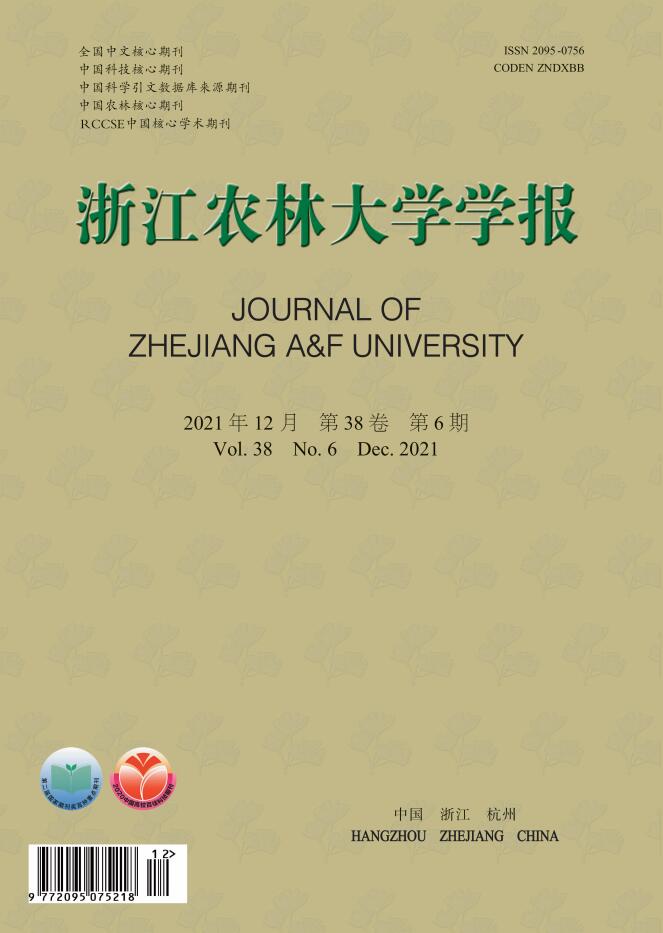-
随着工矿业的发展,矿业冶炼、工业废水及废弃物排放等含镉(Cd)污染物不断进入土壤,土壤镉污染问题日益严重。镉不仅损害植物的生长发育,影响植株的生理代谢,还会在农作物中富集,通过食物链进入人体,威胁人体健康[1],进行镉污染土壤修复研究刻不容缓。土壤镉污染修复技术主要有物理修复、化学修复、生物修复以及多措施联合修复等。与传统的理化修复方法相比,植物修复技术成本低、操作简易,应用广泛[2-3]。但植物材料易受环境等因素影响,因此需要优化植物提取土壤重金属的条件[4]。结合电动修复技术可以提高植物修复效率,具有良好发展前景[5]。研究证实交流电场可以促进黑麦草Lolium perenne[6]、莴苣Lactuca sativa[7]、东南景天Sedum alfredii[8]等植物的生长,加快植物对重金属的吸收积累。植物联合电动修复技术不仅能提高土壤中重金属的有效性,还能促进植物生长和对重金属的富集[9],强化植物吸收修复效率,提升植物修复技术的实际应用前景。水分是贯穿土壤-植物-大气系统的动力因素,不仅直接影响植物的生长,还会通过改变土壤pH、氧化还原状况等影响土壤物质转化,从而间接影响重金属在土壤固-液两相的分配,影响土壤中重金属的有效性和植物对土壤重金属的吸收[10]。ANGLE等[11]对遏蓝菜Thlaspi caerulescens、崖雪球Alyssum murale等的研究表明:随着土壤含水量的增加,植物生物量和对重金属积累能力也随之增加。然而,国内外在关于电场、水分对植物生长和金属吸收性方面研究报道很少。因此本研究以褪色柳Salix discolor、东南景天为对象,采用混栽盆栽试验,研究电场和水分对褪色柳和东南景天生长和对土壤重金属镉吸收积累的影响,为进一步优化提升植物修复土壤重金属镉提供技术支撑。
HTML
-
供试土壤采自温州市农业科学研究院试验基地,为重金属镉污染的耕地土壤。取0~20 cm表层土壤,放于阴凉处风干,过2 mm筛备用。供试土壤理化性质:土壤pH 6.30;有机质41.50 g·kg−1;碱解氮242.00 mg·kg−1;有效磷72.30 mg·kg−1;速效钾354.00 mg·kg−1;有效态镉0.28 mg·kg−1;全镉2.47 mg·kg−1。
供试柳树由江苏宿迁名世园艺提供。将长势良好且相近的褪色柳枝条剪成15 cm长的插条,超纯水洗净备用。东南景天取自浙江省衢州市一古老铅锌矿,栽培于浙江农林大学平山试验基地,选用大小相近东南景天苗植株作为供试材料。
-
将4 kg风干土搅拌均匀后装盆(上直径202 mm,高198 mm,下直径170 mm),褪色柳枝条和东南景天幼苗各5株移栽入盆,随机排列。设置2种电场强度和2种土壤水分,共 4个处理:以不通电、湿润(土壤田间持水量保持为60%)处理为对照(ck),通电、湿润处理为E组,不通电、高水分(土壤田间持水量为100%)处理为W组,通电、高水分处理为EW组。试验前调节各处理土壤含水量,在E组和EW组中每盆插入2根石墨棒,设定电场强度为0.5 V·cm−1[12-14]。各处理重复3次。2019年5月开始试验,隔1周调整1次电压,每日称量加水以保持土壤水分;2019年12月收获植物样品,采集土样。
-
土壤pH采用pH计电位法测定,水土体积质量比为2.5∶1.0;碱解氮、有效磷、速效钾质量分数分别采用碱解扩散法、碳酸氢钠提取-钼锑抗比色法和醋酸铵浸提-火焰光度法测定;土壤有机质采用重铬酸钾外加热法测定[15]。土壤镉全量采用三酸[三酸分别为硝酸(HNO3)、高氯酸(HClO4)、氢氟酸(HF),体积比为5∶1∶1]进行消煮,土壤有效镉采用二乙基三胺五乙酸(DTPA)试剂提取,镉形态分级参照欧洲共同体参考物机构(European Communities Bureau of Reference)改进的三步提取法(BCR)[16],消煮液和提取液最后用石墨炉原子吸收仪(岛津AA-7000)测定。
将所采植物样品分为柳叶、柳枝、东南景天地上部3个部分,用自来水和去离子水各清洗1次,105 ℃杀青15 min,80 ℃下烘干至恒量,磨细过20目筛,供分析测定。植物样品经硫酸-过氧化氢消煮后,用石墨炉原子吸收仪(岛津AA-7000)测定镉质量分数。采用便携式光合作用仪(Li-6400XT)于9:00−11:00在25 ℃下测定褪色柳光合参数[17],分别为净光合速率(Pn)、气孔导度(Gs)、蒸腾速率(Tr)、细胞间隙二氧化碳摩尔分数(Ci)。
-
利用SPSS 21软件进行统计分析数据。计算植物镉积累量(μg·盆−1):ACd=wCd×B,其中wCd为植物Cd质量分数(mg·kg−1),B为植物生物量(g·盆−1)。
1.1. 材料
1.2. 设计
1.3. 样品处理与测定
1.4. 数据处理
-
由表1可知:与对照(ck)相比,高水分+电场处理(EW)下土壤pH显著升高(P<0.05),电场(E)或高水分(W)单独处理对土壤pH无显著影响。W和EW处理下土壤碱解氮质量分数显著提高11.00%、12.09%(P<0.05),E处理下无显著变化。不同处理下土壤中有机质、有效磷质量分数均无显著影响。
处理 pH 有机质/(g·kg−1) 碱解氮/(mg·kg−1) 有效磷/(mg·kg−1) 速效钾/(mg·kg−1) ck 6.18±0.13 b 38.71±2.12 a 192.97±8.17 b 72.85±3.40 a 465.00±13.08 ab E 6.25±0.19 ab 42.75±1.05 a 190.63±12.01 b 72.95±6.95 a 483.30±16.26 a W 6.46±0.18 ab 43.30±4.08 a 214.20±12.14 a 76.58±3.93 a 450.67±16.26 b EW 6.58±0.17 a 43.39±2.13 a 216.30±11.57 a 76.71±5.93 a 469.67±12.58 ab 说明:同列不同字母表示处理间差异显著(P<0.05) Table 1. Effects of different treatments on basic soil chemical properties
-
与ck相比,E处理下土壤有效态镉质量分数显著提高了16.13%(P<0.05),其他处理无显著变化。利用BCR法得到土壤不同形态镉比例,由表2可知:W和EW处理下,土壤酸可提取态镉和可还原态镉比例分别显著降低了2.78%、6.16%和2.72%、8.44%(P<0.05),土壤残渣态镉比例则显著提高(P<0.05)。W处理下,土壤可氧化态镉比例显著提高(P<0.05),E处理对土壤所有镉形态均无显著影响(P>0.05)。
处理 有效镉/(mg·kg−1) 酸可提取态/% 可还原态/% 可氧化态/% 残渣态/% ck 0.31±0.02 b 14.23±1.37 a 37.45±2.29 a 2.53±0.49 b 45.79±2.19 b E 0.36±0.04 a 14.59±1.17 a 38.90±2.04 a 3.13±0.66 ab 43.38±2.63 b W 0.31±0.03 b 11.45±0.76 b 31.29±2.13 b 3.70±0.48 a 53.56±1.51 a EW 0.35±0.01 ab 11.51±0.62 b 29.01±2.42 b 3.22±0.27 ab 56.27±1.90 a 说明:同列不同字母表示处理间差异显著(P<0.05) Table 2. Effects of different treatments on soil available Cd and its fractionations
-
由表3可知:与ck相比,W处理后,柳叶、柳枝生物量分别提高15.61%和27.11%(P<0.05),东南景天生物量显著降低60.24%(P<0.05);EW处理后,柳叶、柳枝生物量分别提高34.39%和101.10%(P<0.05),东南景天显著降低22.02%(P<0.05);E处理对柳叶、柳枝及东南景天生物量均未产生显著影响。不同处理对褪色柳各项光合参数均未造成显著影响。综合来看,EW处理促进褪色柳生长的效果最佳,其柳叶、柳枝生物量分别是W处理的1.16和1.58倍,是E处理的1.25和2.08倍。
处理 柳叶干质量/
(g·盆−1)柳枝干质量/
(g·盆−1)东南景天地上部
干质量/(g·盆−1)Tr /
(mmol·m−2·s−1)Pn /
(μmol·m−2·s−1)Ci /
(μmol·mol−1)Gs /
(mol·m−2·s−1)ck 5.70±1.21 a 2.73±0.47 c 1.33±0.26 ab 5.24±0.43 a 11.64±2.12 ab 312.11±19.30 ab 0.28±0.03 a E 6.13±0.71 a 2.64±0.25 c 1.49±0.28 a 4.98±2.33 a 13.96±5.86 a 301.03±11.12 b 0.29±0.13 a W 6.59±0.44 a 3.47±0.23 b 0.83±0.11 c 4.94±1.94 a 6.45±0.85 b 341.40±16.36 a 0.27±0.12 a EW 7.66±1.60 a 5.49±0.39 a 1.09±0.10 bc 5.60±1.59 a 7.83±0.73 ab 340.52±15.43 a 0.32±0.11 a 说明:同列不同字母表示差异显著(P<0.05) Table 3. Effects of different treatments on plant biomass and photosynthesis of S. discolor
-
由表4可知:与ck相比,W和EW处理的柳叶镉质量分数分别显著降低106.91%、156.13%(P<0.05),柳枝镉质量分数分别显著降低113.13%、165.80%(P<0.05);柳叶镉积累量分别显著降低82.81%、95.60%(P<0.05),东南景天地上部镉积累量分别降低63.15%和18.02%。而E处理中柳叶、东南景天地上部镉质量分数与对照相比分别提高6.68%、9.59%;柳叶、东南景天地上部镉积累量与ck相比分别提高12.61%、22.50%。各处理褪色柳和东南景天地上部镉总积累量由高到低依次为:E、ck、EW、W。
处理 镉质量分数/(mg·kg−1) 植物镉积累量/(μg·盆−1) 柳叶 柳枝 东南景天地
上部柳叶 柳枝 东南景天地上部 总地上部 ck 6.89±1.04 a 9.25±1.31 a 36.19±2.02 ab 39.98±13.30 a 25.69±8.00 a 48.00±7.63 ab 113.68±15.48 a E 7.35±0.30 a 9.36±1.87 a 39.66±2.32 a 45.02±4.70 a 24.54±3.88 a 58.80±8.80 a 128.36±7.06 a W 3.33±0.65 b 4.34±1.07 b 35.27±1.36 b 21.87±4.03 b 15.20±4.64 a 29.42±4.59 c 66.49±6.32 b EW 2.69±0.49 b 3.48±0.59 b 37.49±1.69 ab 20.44±4.64 b 19.20±4.39 a 40.67±2.00 bc 80.31±4.99 b 说明:同列不同字母表示处理间差异显著(P<0.05) Table 4. Effects of different treatments on Cd absorption and accumulation in S. discolor and S. alfredii
2.1. 不同处理下土壤的理化性质
2.2. 不同处理对土壤镉有效性及镉形态转化的影响
2.3. 不同处理对褪色柳和东南景天生长的影响
2.4. 不同处理对褪色柳和东南景天镉吸收积累的影响
-
土壤速效养分是土壤肥力的重要指标,一定程度上反映了近期土壤对植物养分的供应情况[18]。土壤碱解氮主要来源于有机氮的矿化分解,属于有效氮,是土壤中能够被植物直接吸收利用的氮素[19-20]。本研究发现:施加电场对土壤理化性质无显著影响;高水分+电场处理显著提高碱解氮质量分数,但对有效磷、速效钾无显著影响。研究[21-22]发现:长期高水分处理会使植株叶片叶绿素发生降解,导致叶片衰老凋落,可能是土壤碱解氮质量分数升高的原因。同时,长时间的高水分处理会使土壤二氧化碳排放受阻,反应产生碳酸盐,提高土壤pH[23-24]。
-
重金属的生物活性不仅与其总量有关,更大程度上由其存在形态决定。重金属的不同形态会产生不同的环境效应,直接影响其迁移和在自然界的循环[25-26]。本研究发现:施加电场显著提高了土壤有效镉质量分数,土壤金属离子活性的提高,有利于残渣态镉向交换态镉转化[6, 27]。同时发现:高水分处理下,酸可提取态镉、可还原态镉比例显著降低,残渣态镉比例显著提高,这与LI等[28]的研究结果一致。推测原因在于长期高水分处理下,土壤氧化还原电位(Eh)降低,土壤还原状况加强,土壤中还原态阳离子(如铁、锰离子)和阴离子(如硫离子)相对含量增加,硫离子与镉形成难溶的硫化物沉淀的机率提高[29-30]。水分还会影响铁离子的氧化还原过程[31],长期高水分处理促进氧化铁还原,形成新的镉氧化物。因此,土壤高水分处理降低了土壤镉的有效性。
-
水分是影响植物生长发育的重要因素[32]。本研究表明:高水分处理后东南景天生物量的降低可能是由于土壤水分含量高导致根际缺氧,从而抑制了其正常生长[33]。而褪色柳喜湿耐涝,具有较强的耐水性,为耐水湿类树种[34],在高水分处理中表现为更有利于其生长。电场+高水分加快了褪色柳细胞分裂、分化,促进褪色柳对营养元素的吸收,从而使褪色柳地上部的生物量提高[35-36]。
-
褪色柳生长迅速,东南景天吸收重金属的能力强,作为重要的镉富集和超积累植物,褪色柳-东南景天混栽有利于单位面积土壤上植物对土壤中镉的高效吸收[37]。在评价植物对镉污染土壤修复效率时,主要考虑地上部镉积累量[8]。研究发现:湿润条件下施加电场,有利于褪色柳和东南景天生长;同时提高了土壤有效镉质量分数,促进植物根系对镉的吸收[38],有利于褪色柳、东南景天对其的积累[39]。高水分处理下,土壤pH升高,土壤溶液中多价阳离子和氢氧根离子(OH−)增多,加大了氢氧化镉沉淀生成的机率,使土壤镉的有效性降低[40];与此同时,高水分下东南景天生物量也降低,褪色柳和东南景天对土壤中镉的积累受到抑制。
因此,土壤湿润条件比淹水处理更有利于褪色柳-东南景天混栽对土壤中重金属镉的吸收和积累。受时间限制,本研究仅在褪色柳苗期进行,就积累镉质量分数的顺序来看,东南景天地上部要好于柳叶和柳枝。
3.1. 水分和交流电场对土壤理化性质的影响
3.2. 水分和交流电场对土壤镉有效性及其形态的影响
3.3. 水分和交流电场对褪色柳和东南景天生长的影响
3.4. 水分和交流电场对褪色柳和东南景天镉吸收、积累的影响
-
交流电场的施加可提高土壤有效镉质量分数,促进褪色柳-东南景天地上部对镉的积累,对土壤理化性质及土壤中镉形态分布无显著影响。高水分处理提高了土壤碱解氮质量分数以及可氧化态镉和残渣态镉比例,但会抑制东南景天生长,降低褪色柳、东南景天对镉的积累。因此,适宜水分条件下,施加电场有利于褪色柳-东南景天混栽对土壤中重金属镉的吸收和积累。









 DownLoad:
DownLoad: